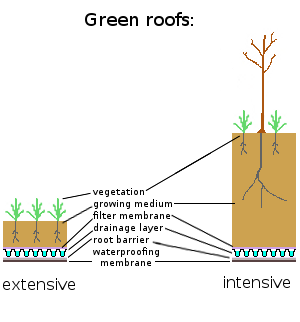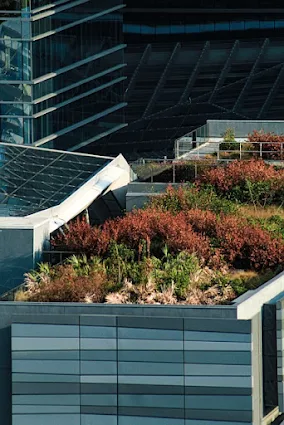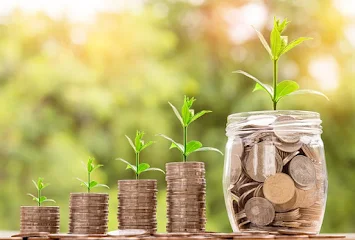Transitioning from traditional roofs to a green roofs is not without its challenges, but the benefits can far outweigh these.
Green Roof Structural Considerations
Switching to a green roof offers a host of ecological advantages, from improved insulation to reduced stormwater runoff. However, before you make the transition, it's imperative to evaluate key structural factors that can influence the sustainability and safety of your green roofing system.
Calculating the Weight Load of a Green Roof
The weight burden varies substantially between different green roof models. For instance, extensive green roofs, designed with a thinner layer of soil and lightweight plants like sedum, usually add between 15 to 50 pounds per square foot (psf). In contrast, intensive green roofs, which can accommodate diverse vegetation like shrubs and trees due to their deeper soil base, can add a load of 80 to 150 psf or even higher. This weight calculation should include all components of the green roof system—plants, soil, water, and ancillary materials.
Expert Structural Evaluation
Given the extra load a green roof adds, consulting a qualified structural engineer is a must. The expert will assess the existing or proposed building structure to verify its capability to sustain the added weight. Additionally, they will take into account other factors like water retention during severe weather and any maintenance staff who may need to be on the roof.
Adhering to Local Building Regulations
Compliance with local building codes is non-negotiable. These rules may differ greatly depending on your geographical location. For instance, some localities may mandate green roofs on specific building types, while others might restrict their implementation due to structural integrity or fire safety issues.
Waterproofing and Efficient Drainage Systems
One of the critical elements in green roof construction is a robust waterproofing membrane that shields the underlying structure from potential water-related damages. Equally important is a well-planned drainage network to prevent water accumulation on the roof, which could lead to additional weight and structural risks.
Considering Roof Slope in Design
The roof’s inclination angle is a significant variable that impacts the feasibility and design of your green roof project. While flat or low-slope roofs are generally more conducive to green roofing, specialized engineering can adapt green roof systems to work on sloping surfaces as well.
Ease of Maintenance Access
If your green roof demands regular upkeep, ensuring easy and safe access to the rooftop is vital. Moreover, the frequent foot traffic on the maintenance pathways might necessitate added structural support.
Green Roof Installation Guide: A Step-By-Step Overview
Embarking on a green roof installation involves multiple complex steps, requiring meticulous planning and specialized know-how. Below is a detailed breakdown of the standard stages integral to setting up a successful green roof.
Initial Planning and Design Considerations
Preparation and Design: The first step consists of a comprehensive structural review of the building, along with selecting the most suitable type of green roof—be it extensive, intensive, or semi-intensive. You'll also need to pick the appropriate vegetation and map out the roof’s layout. Variables like regional climate, compliance with building regulations, and the property owner's preferences and budget are also integral to this stage.Structural Integrity Evaluation: As previously noted, a specialized structural engineer's assessment is vital to ascertain that the building can withstand the added weight of your green roof system. This includes not only the weight of the soil and plants but also water retention and any personnel for maintenance.
Preparing the Roof Structure
Waterproofing Measures: Before proceeding with installation, it's essential to lay down a robust waterproof membrane to prevent water infiltration into the building. Commonly used materials for this include EPDM, PVC, or TPO, each offering durability and resistance to root encroachment.
Root Barrier Installation: A root barrier layer is installed atop the waterproofing membrane for added root damage prevention. It is generally made from a thin yet impenetrable material.
Optional Insulation Layer: Depending on the climate and the existing building insulation, an extra layer of insulation may be added to enhance the building's energy efficiency.
Drainage, Filtration, and Growing Medium
Installing the Drainage Layer: A specialized drainage system is laid next, designed to manage excess water and prevent pooling, which could compromise the roof’s structure and promote bacterial or fungal growth. This layer often consists of lightweight aggregates or specialized plastic or fabric mats.
Filter Fabric Layer: Above the drainage, a filter fabric is placed to keep the growing medium from eroding into and clogging the drainage system, while still permitting water to pass through.
Preparing the Growing Medium: The plants will thrive in a specially engineered soil known as the growing medium. This isn’t your regular garden soil; it’s formulated for optimal water retention, drainage, and resistance to compaction and degradation.
Final Planting Stage
Plant Installation: The last phase involves planting the preselected vegetation, with choices that may span from resilient sedums for extensive green roofs to more elaborate grasses, wildflowers, shrubs, and even trees for intensive systems.Each layer and phase is crucial, designed to work in harmony to create a sustainable, beautiful, and functional green roof.
 |
Green Roof Maintenance Guide: Extensive vs. Intensive Systems
Caring for your green roof is a critical component of its long-term performance and sustainability. The maintenance demands differ based on the type of green roofing system you have—either extensive or intensive. Here's a comprehensive guide to understanding how to maintain each type:
Extensive Green Roof Maintenance
Extensive green roofs are engineered to be relatively low-maintenance. They often feature shallow growing mediums—usually less than 6 inches deep—and are planted with resilient, drought-tolerant plants like sedums. The idea is to largely depend on natural rainfall for irrigation.
Key Maintenance Tasks:
Weeding: Periodic removal of unwelcome plant species that might have taken root is essential.
Drainage Inspection: Ensure the drainage system is operating effectively and that the waterproofing layer remains intact.
Plant Replacement: On occasion, some plants may die off and will need to be replaced, although the aim is to select flora robust enough to minimize this need.
Nutrient Replenishment: The soil nutrients might deplete over time and could require fortification with slow-release fertilizers.
Intensive Green Roof Maintenance
Also known as rooftop gardens, intensive green roofs are more intricate and feature a deeper soil profile capable of supporting a diverse range of plants, from grasses to trees.
Key Maintenance Tasks:
Regular Watering: Frequent irrigation is often necessary, particularly during dry spells.
Pruning and Trimming: As with a traditional garden, plants may need regular pruning or trimming.
Weed Control: Routine weeding is essential to eliminate invasive species that could choke out desired plants.
Soil Fertilization: The growing medium usually needs fertilizing to maintain soil health and plant vitality.
Plant Health Monitoring: Keep an eye on plant health, replacing any diseased or dead plants as needed.
Irrigation and Drainage Checks: Regular evaluations of the irrigation and drainage systems are vital for their optimal functioning.
Importance of Professional Inspection
Regardless of the green roof type, an annual inspection—preferably conducted in the spring—is recommended to be carried out by a specialized professional. This is crucial for assessing the general health and structural integrity of the roof and its components, allowing you to address any emerging issues proactively.
Why Regular Maintenance Matters
Investing in regular upkeep is critical for multiple reasons. Well-maintained green roofs perform more efficiently in functions like stormwater management, thermal regulation, and promoting biodiversity. Plus, a properly cared-for green roof is likely to have a longer lifespan.
The Financial Aspects of Green Roof Systems: Costs vs. Benefits
Green roofs, while offering a plethora of ecological and aesthetic advantages, do tend to cost more than traditional roofing solutions. Here's a breakdown of the various cost components and long-term financial benefits associated with green roofs.
Initial Investment: Factors That Influence Cost
Specialized Materials: Unlike traditional roofs, green roofs require multiple specialized components such as a waterproof membrane, a root barrier, drainage systems, filter fabric, engineered soil, and plant materials. These are all critical for the optimal functioning and longevity of a green roof.
Structural Modifications: Given their added weight, green roofs often require enhanced structural support. This could mean either reinforcing the existing building or incorporating the needed support into new building designs—both of which incur additional costs.
Labor and Expertise: Green roof installation is a specialized skill. Professionals with expertise in this area may charge a premium for their services. The multi-step installation process, covering everything from waterproofing to planting, further compounds labor costs.
Design Complexity: Planning a green roof involves intricate design considerations, including plant selection, soil depth, drainage, irrigation, and aesthetics, all of which require specialized knowledge.Recurring Expenditures: Operational Costs
Maintenance: The upkeep costs vary between extensive and intensive systems. Extensive green roofs generally have lower maintenance demands, whereas intensive systems are more akin to traditional gardens in their upkeep requirements.Long-Term Financial Benefits
Extended Roof Lifespan: Green roofs protect the roofing membrane from weather extremes and UV radiation, potentially doubling or tripling its life expectancy. This translates into long-term cost savings.
Energy Efficiency: The insulating properties of green roofs can lead to significant energy savings by keeping buildings cooler in the summer and warmer in the winter.
Stormwater Fee Reduction: Some local governments offer reduced stormwater fees for properties with green roofs, as they help manage runoff and relieve stress on municipal drainage systems.
Potential Increase in Property Value: Though difficult to quantify, a well-maintained green roof can enhance a building's aesthetic appeal and biodiversity, potentially boosting its market value.
Human Wellbeing: Not a direct financial gain, but green roofs can enhance occupant wellbeing, potentially leading to increased productivity in work settings and an overall improved quality of life in residential buildings.
Financial Incentives: Various municipalities offer grants, tax incentives, or other financial benefits for green roof installations as part of environmental sustainability programs.
A New Horizon in Urban Sustainability
Green roofs represent an exciting shift in sustainable urban living. Cities like Toronto, Copenhagen, and Stuttgart have already incorporated green roofs into their urban planning regulations and policies, recognizing their immense environmental and societal benefits.
By choosing to install a green roof, you're not just choosing a sustainable alternative for a traditional lawn. You're making a commitment to biodiversity, energy efficiency, and a healthier urban environment. It's about reimagining our relationship with nature and reshaping our cities for the better.




No comments:
Post a Comment